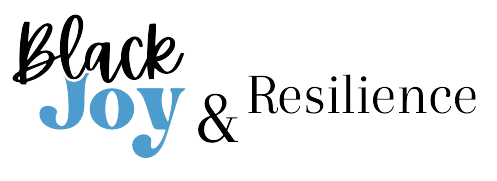Items
Tag
Representation
-
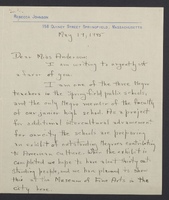 Letter, Rebecca Johnson to Miss Anderson, May 19, 1945 This letter was sent by Miss Rebecca Mary Johnson (July 10, 1905-October 4, 1991) to Miss Marian Anderson (February 27, 1897-April 8, 1993) on May 19, 1945. This letter was sent to share details about “a project for… intercultural advancement” that will feature famous Black Americans, like Marian Anderson (p. 1). Johnson asks Anderson questions about herself to be used in the exhibit for the benefit of the Springfield, Massachusetts community and youth.
Letter, Rebecca Johnson to Miss Anderson, May 19, 1945 This letter was sent by Miss Rebecca Mary Johnson (July 10, 1905-October 4, 1991) to Miss Marian Anderson (February 27, 1897-April 8, 1993) on May 19, 1945. This letter was sent to share details about “a project for… intercultural advancement” that will feature famous Black Americans, like Marian Anderson (p. 1). Johnson asks Anderson questions about herself to be used in the exhibit for the benefit of the Springfield, Massachusetts community and youth. -
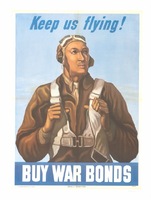 Keep Us Flying poster Poster created by the U.S. Treasury Department during World War II to encourage war bond purchase.
Keep Us Flying poster Poster created by the U.S. Treasury Department during World War II to encourage war bond purchase. -
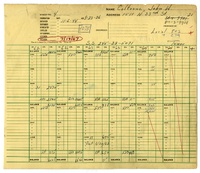 John W. Coltrane dues record A 2-page balance sheet of union dues from legendary jazz saxophonist, composer, and band leader John William Coltrane (1926-1967). The dues are for local chapters of the American Federation of Musicians (AFM) of which John Coltrane was a member–Local 802 serving New York and Local 274 for Philadelphia.
John W. Coltrane dues record A 2-page balance sheet of union dues from legendary jazz saxophonist, composer, and band leader John William Coltrane (1926-1967). The dues are for local chapters of the American Federation of Musicians (AFM) of which John Coltrane was a member–Local 802 serving New York and Local 274 for Philadelphia. -
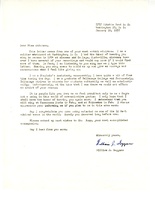 Letter, William J. Goggans to Miss Anderson, January 26, 1957 A typed letter from then soldier, educator, and musician William James Goggans (1933-2003) to globally renowned contralto Marian Anderson Fisher (1897-1993). In his letter, Goggans expresses his admiration for Marian Anderson. He congratulates her for being selected as one of the 10 most admired women in the world and asks her to inform him if she plans to perform in the Washington, D.C. area in the near future.
Letter, William J. Goggans to Miss Anderson, January 26, 1957 A typed letter from then soldier, educator, and musician William James Goggans (1933-2003) to globally renowned contralto Marian Anderson Fisher (1897-1993). In his letter, Goggans expresses his admiration for Marian Anderson. He congratulates her for being selected as one of the 10 most admired women in the world and asks her to inform him if she plans to perform in the Washington, D.C. area in the near future. -
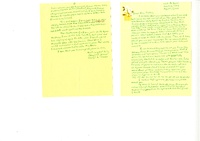 Letter, Cheryl G. Jones to Miss Anderson, August 27, 1969 An envelope, two-page letter, and signed photograph mailed by high school student and aspiring singer Cheryl G. Jones to globally renowned contralto Marian Anderson Fisher (1897-1993). The letter is among many letters from aspiring singers and musicians included in the Marian Anderson Papers. Anderson's life was an inspiration to them and to countless others in the United States and abroad (Kruesi 1998).
Letter, Cheryl G. Jones to Miss Anderson, August 27, 1969 An envelope, two-page letter, and signed photograph mailed by high school student and aspiring singer Cheryl G. Jones to globally renowned contralto Marian Anderson Fisher (1897-1993). The letter is among many letters from aspiring singers and musicians included in the Marian Anderson Papers. Anderson's life was an inspiration to them and to countless others in the United States and abroad (Kruesi 1998). -
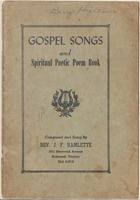 Gospel Songs and Spiritual Poetic Poem Book The book “Gospel Songs and Spiritual Poetic Poem Book” by Rev. J. F. Hamlette has four parts and is 56 pages. It has handwritten inscriptions of Ada and George Hightower's names on cover and inside, who were members of the First Colored Church in Hopewell, NJ and were among the first African Americans to live on Columbia Avenue in Hopewell.
Gospel Songs and Spiritual Poetic Poem Book The book “Gospel Songs and Spiritual Poetic Poem Book” by Rev. J. F. Hamlette has four parts and is 56 pages. It has handwritten inscriptions of Ada and George Hightower's names on cover and inside, who were members of the First Colored Church in Hopewell, NJ and were among the first African Americans to live on Columbia Avenue in Hopewell. -
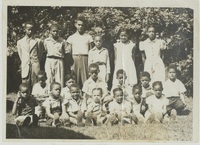 Bethel African Methodist Episcopal Church Sunday School The Bethel AME Church in Pennington was built in 1816 by a small group of free African Americans who purchased the land as an empty lot, as well as nearby lots for homes (Katmann 2014, 6). This photograph of the church’s Sunday School features nineteen children, some siblings. Patricia (née True) Payne has identified all of the children in the picture. (See reverse)
Bethel African Methodist Episcopal Church Sunday School The Bethel AME Church in Pennington was built in 1816 by a small group of free African Americans who purchased the land as an empty lot, as well as nearby lots for homes (Katmann 2014, 6). This photograph of the church’s Sunday School features nineteen children, some siblings. Patricia (née True) Payne has identified all of the children in the picture. (See reverse) -
 Handwritten Stoutsburg Cemetery Ledger This handwritten ledger was kept by Herbert Albert Hubbard (June 7, 1875-July 11, 1948), Beverly Mills's (co-founder of the Stoutsburg Sourland African American Museum) great-grandfather, at the Stoutsburg Cemetery. It includes minutes from Stoutsburg Cemetery Association meetings, including hymns sung and fundraising efforts, from 1912 through the 1920s.
Handwritten Stoutsburg Cemetery Ledger This handwritten ledger was kept by Herbert Albert Hubbard (June 7, 1875-July 11, 1948), Beverly Mills's (co-founder of the Stoutsburg Sourland African American Museum) great-grandfather, at the Stoutsburg Cemetery. It includes minutes from Stoutsburg Cemetery Association meetings, including hymns sung and fundraising efforts, from 1912 through the 1920s. -
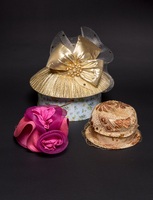 Group of 1930's - 1940's Church Hats Church hats that would have been worn by the ladies of Mt. Zion AME Church in the late 20th century.
Group of 1930's - 1940's Church Hats Church hats that would have been worn by the ladies of Mt. Zion AME Church in the late 20th century. -
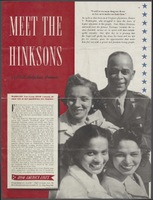 “Meet the Hinksons.” “Meet the Hinksons of Philadelphia, Penna.” is a six-page magazine article published in the Ladies’ Home Journal series “How America Lives” in August 1942. The article highlights the everyday life of the Hinkson family, including education, careers, fashion, travel, and home, and the impact of various wars on their lives.
“Meet the Hinksons.” “Meet the Hinksons of Philadelphia, Penna.” is a six-page magazine article published in the Ladies’ Home Journal series “How America Lives” in August 1942. The article highlights the everyday life of the Hinkson family, including education, careers, fashion, travel, and home, and the impact of various wars on their lives. -
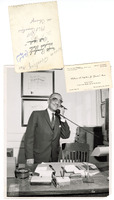 William Upshur on phone at desk A black and white photograph taken by John W. Mosley (1907-1969) featuring William “Bill” Arthur Upshur Jr. (1894-1963) on the phone at his office desk. His business card for his funeral home is stapled to the photo. Another photo flipped right side down sits above. It has handwritten inscriptions.
William Upshur on phone at desk A black and white photograph taken by John W. Mosley (1907-1969) featuring William “Bill” Arthur Upshur Jr. (1894-1963) on the phone at his office desk. His business card for his funeral home is stapled to the photo. Another photo flipped right side down sits above. It has handwritten inscriptions.
